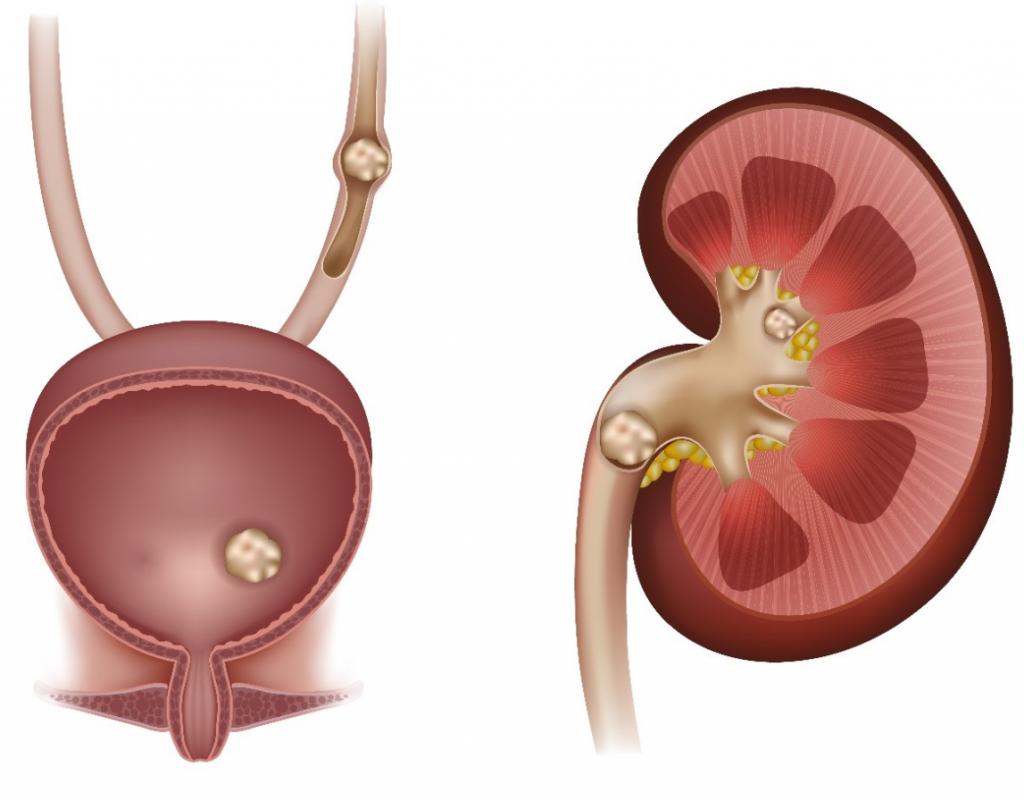Major Kidney Stone Symptoms – Tests and Treatments

Kidney stone symptoms sometimes left unnoticed and may go undetected as well. Small stones can even pass out from the urinary tract without even get noticed.
What are kidney stones?
Kidney stones are small crystals of minerals and salt that may stick together over a period in the kidney forming a stone- a huge concentration of the minerals and salts in urine.
Many people believe that improper diet and lifestyle changes are connected to kidney stones. It is advised that one should avoid red meat, organic meat and shellfish to avoid uric acid stones. It is also believed that eating less animal-based protein and eating more fruits and vegetables will help decrease urine acidity reducing the chance for stone formation. Many scientists believe that drinking more fluid reduces the risk of occurring Kidney stone symptoms, as it normalises the concentration of salts minerals in the urine.
It is a known fact that the size of the kidney stones vary from that of grain to a golf ball! If they are small, they may pass through the urinary tract without any medical treatment. Big stones, though, are unable to pass through the urinary tract, therefore, leading to severe pain.
Kidney Stone Symptoms
[show_more more=”Continue Reading ▼” less=”Show Less ▲”]
- Excruciating pain at the side of their back or lower abdomen: The location of the stone affects the type of symptoms you experience. People have described the feeling of kidney stones as a sharp pain on one side of their back or lower abdomen. The pain often starts abruptly and lingers, therefore becoming more intense over time. Patients experience constant pain that may frequently happen in waves, sometimes last for few minutes and disappears. The change in the level of intensity may occur as the stone moves to a different position in the urinary tract.
- Blood in the urine (Hematuria): It includes:
- Pain while urinating,
- Urine appears cloudy,
- Urine that smells differently than it normally does,
- Urge to urinate more often than usual,
- Burning sensation while urinating.
- Urine colour might change to pinkish or reddish. Sometimes blood in the urine can only be detected with a microscopic examination of urine.
- Gravels: Though the small stones do not cause any pain or any symptom, they are noticeable in the urine.
- Extreme pain during urination: It is one of the most important kidney stone symptoms and occurs when the stone comes down to the ureter.
- Other symptoms: Some types of kidney stones, called struvite stones, are caused by urinary tract infections leading to infection in kidneys as well, the urinalysis shows infectious cells in the urine and cause symptoms like:
- Nausea
- Vomiting
- Chills
- Fever
Both urinary tract and kidney infections lead to sepsis- a potentially life-threatening and whole body inflammatory condition; that occurs when the body releases into the blood to fight an infection.
Asymptomatic Kidney Stones: A Type
In some cases, the stones remain in the kidney and causes no disruption. These are later identified if one goes through a CT scan or an X-ray for other purposes.
When should one take medical help?
Early diagnosing is important for any types of diseases. One should immediately seek medical help if he/she is suffering from the initial kidney stone symptoms, such as:
- Pain that becomes so severe that one can’t even sit, stand or lie down comfortably.
- An occurrence of blood in the urine.
- Pain accompanied by fever and chills.
- Facing extreme difficulty while urinating.
Tests for Diagnosing Kidney Stones
- A blood test should be taken where the information about the excess chemicals and substances present in the body can be determined.
- Getting a urine analysis test done so that the doctor should have the available information about the urine composition which helps him to detect any infection.
- Getting an X-ray image where the stones become visible as white spots that usually contain calcium.
- Kidney function tests should be done.
- One can also undergo an Intravenous Urogram (IVU), a special dye that is injected and helps to detect more stones that are hard to see in an ordinary x-ray.
- Taking non-contrast Helical- computerized tomography is helpful in projecting images with varied angles to detect and diagnose kidney stones. Several medical practitioners consider this as the most efficient and accurate diagnostic examination.
Home Treatments for Kidney Stones
- One should drink almost 8-10 glasses of water per day.
- Exercising regularly to remain physically active is essential.
- Home remedies like the combination of lemon juice and olive oil traditionally used to discharge gallbladder stones are helpful to treat kidney stones as well. This happens due to the presence of citric acid present in lemons that helps in breaking down calcium-based kidney stones thereby stops further growth. Juice of watermelon and pomegranate are very helpful in the prevention of occurrence of kidney stone symptoms.
- A medical prescription for paracetamol or codeine that helps to alleviate the pain of naturally passing stones out with water.
- The best way to identify whether symptoms are related to the kidney stone or not is to notice the time of occurrence of pains. As the ureter is constricted during late night and early morning, therefore, the pain becomes severe during these times.
However, if despite these simple treatments the kidney stone symptoms persist, doctors then switch to modern surgical procedures such as Shockwave Lithotripsy, tunnel surgery, ureteroscopy, Parathyroid gland surgery and more. Several additional prescribed antibiotics can also prevent infection from spreading out in other parts of the body.
In some cases, kidney stone symptoms are so severe that immediate hospitalisation becomes necessary. Symptoms of kidney stones often go untreated resulting a worst condition of the patient. Therefore, early diagnosis and extra precautionary measures should be taken in order to remain perfectly healthy and physically fit. [/show_more]














